Antarctica by Redeye
Yesterday we didn’t sleep much. We boarded our plane to Antarctica at 10 p.m., and by 4:20 in the morning we were standing on a carpet of sea ice. The sun was warm on my face, the sky was a spotless blue, and not many people needed their Big Red parkas. The temperature rose to 36 degrees.
We spent our day moving through a succession of large vehicles: a giant C-17 jet, a very large people-mover called Ivan the Terra-Bus, and finally onto our home for the next month, the great big Nathaniel B. Palmer icebreaker. Read on through the slideshow for the full story.
- The C-17 that took us to Antarctica is an enormous jet, capable of taking 120 people and several hundred thousand pounds of cargo the 2,000 miles to the ice in just over 5 hours. We boarded it in darkness, climbing the short ladder and walking into a brightly lit interior. In just a few hours we replayed this in reverse, climbing out of the dimly lit cabin and into a sparkling world of ice and sky.
- Scientists of all types come to Antarctica. On our flight we had physicists, biologists, engineers, chemists, and geologists, as well as McMurdo staff preparing to spend the whole of the Antarctic winter down on the ice—six months with no visitors. Everyone is excited to visit such a remote part of the world. Here, graduate student Elizabeth Halliday, who is studying phytoplankton on our voyage, shows her photos to a couple of Swedish physicists bound for the South Pole’s Ice Cube project. They study subatomic particles called neutrinos using a detector that is a kilometer wide, a kilometer long, and a kilometer deep in the polar ice.
- Inside the C-17 it’s easy to forget you are in a plane. The windows are about 10 feet off the floor, meaning you can’t see outside. The walls are covered with ventilation ducts, wiring, and spare equipment; the ceiling seems almost out of sight. People sit along the walls and in the center aisle along with oversize pieces of cargo (see next image). Everyone wears earplugs to drown out the plane’s noise, and I couldn’t tell we were on the runway until the thrust from the jet engines pushed me backward.
- In the previous picture, that wood ‘wall’ you see in the background is only about halfway down the plane. Behind it there’s still room for a brand-new, cherry-red Pisten Bully. It’s a caterpillar-tracked vehicle great for traversing uneven rocky ground, snow, and ice. Scientists use it to transport people and tow gear across the sea ice.
- We took off in the middle of the night, but a few hours later we were far enough south that the sun had come back up. At first we saw open ocean, and then the first peaks of Victoria Land, the mountainous terrain that forms the western edge of the Ross Sea. In a few days we’ll be back up here, near Cape Adare, to work on recovering Dr. Bruce Huber’s deep-water instruments after three years underwater.
- It’s impossible to forget the moment you climb out, eyes blinking, into the blinding white of Antarctica. We’ve landed on a runway made of sea ice—the only flat surface around. Great mountain ranges sit on the horizon, reminding us that we are on the edge of a vast, uninhabited, unspoiled wilderness. This ice merges with the Ross Ice Shelf and stretches 800 miles southward in an unbroken sheet. The dry, clear air plays tricks with your eyes and makes distant objects clearly visible.
- After everyone has a chance to snap a few photos and take in their first view of the Great White Continent, we board an immense transport lovingly called Ivan the Terra-Bus. It takes us back 10 miles across the ice to Hut Point and McMurdo Station. At one point the driver calls out as he notices a couple of emperor penguins that have wandered into view in the distance.
- Observation Hill is the highest promontory above McMurdo Station. We’re at the southern end of the Ross Sea here—when the ice breaks out, this will be the southernmost open water in the world. This area has been home to Antarctic explorers since 1901—the expedition’s hut is still standing in the distance, next to our orange-hulled ship. These days, more than 1,000 people live here during the summer (about 200 spend the winter). Right now it’s a bustling town, with water melting in the warm sun and heavy trucks shuttling equipment along the gravel roads. Many of them are headed down to the ice pier, loaded with equipment for our voyage.
- Our ship, the Nathaniel B. Palmer, is docked and waiting for us at the ice pier. The ship, built in 1992, is 308 feet long, with a displacement of 6900 tons. Things have come a long way since Capt. Ross’s 1841 journey to the Ross Sea. His two ships had no engines at all—they were 100-foot, 340-ton sailboats made of wood reinforced with copper. The Palmer is an icebreaker capable of plowing through three feet of ice at a speed of 3 knots (1 knot = 1 nautical mile per hour, or about 1.1 mph). In the distance you can see the Royal Society mountain range, marking the southern end of Victoria Land.
- Tonight is our first night sleeping on the ship. We’ll finish setting up scientific equipment tomorrow, and we’ll leave the dock in the early evening.


 January 18, 2011
January 18, 2011 
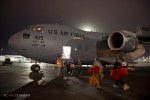
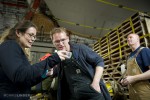


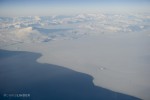
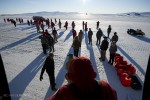
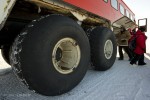
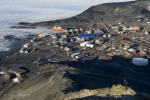
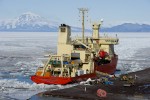
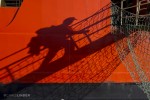







19 Responses to “Antarctica by Redeye”